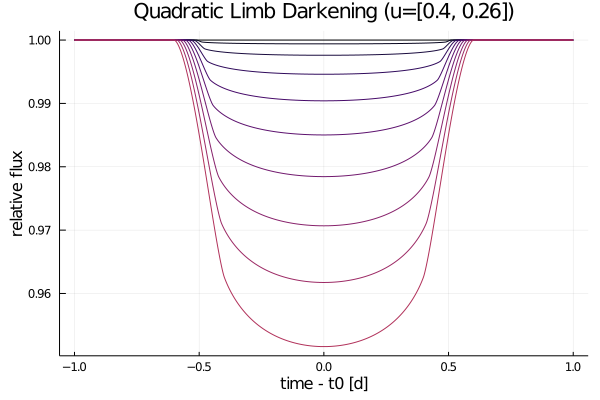Getting Started
Usage
using Orbits
using Transits
orbit = SimpleOrbit(period=3, duration=1)
u = [0.4, 0.26] # quad limb dark
ld = PolynomialLimbDark(u)
t = range(-1, 1, length=1000) # days from t0
rs = range(0, 0.2, length=10) # radius ratio
fluxes = @. ld(orbit, t, rs')
Integrated and Secondary Curves
IntegratedLimbDark can be used to numerically integrate each light curve exposure in time
ld = IntegratedLimbDark([0.4, 0.26])
orbit = SimpleOrbit(period=3, duration=1)
t = range(-1, 1, length=1000)
texp = [0.1 0.2 0.3]
# no extra calculations made
flux = @. ld(orbit, t, 0.2)
# use quadrature to find time-averaged flux for each t
flux_int = @. ld(orbit, t, 0.2, texp)
SecondaryLimbDark can be used to generate secondary eclipses given a surface brightness ratio
ld = SecondaryLimbDark([0.4, 0.26], brightness_ratio=0.1)
ld_int = IntegratedLimbDark(ld) # composition works flawlessly
orbit = SimpleOrbit(period=4, duration=1)
t = range(-1.25, 2.75, length=1000)
rs = range(0.01, 0.1, length=6)
f = @. ld(orbit, t, rs')
f_int = @. ld_int(orbit, t, rs', texp=0.3)
Using Units
Units from Unitful.jl are a drop-in substitution for numbers
using Unitful
orbit = SimpleOrbit(period=10u"d", duration=5u"hr")
t = range(-6, 6, length=1000)u"hr"
flux = @. ld(orbit, t, 0.1)Gradients
Gradients are provided in the form of chain rules. The easiest way to access them is using an automatic differentiation (AD) library like ForwardDiff.jl or Zygote.jl.
using Zygote
ts = range(-1, 1, length=1000) # days from t0
ror = 0.1
u_n = [0.4, 0.26]
orbit = SimpleOrbit(period=3, duration=1)
lightcurve(X) = compute(PolynomialLimbDark(X[3:end]), orbit, X[1], X[2])
# use Zygote for gradient
flux = [lightcurve([t, ror, u_n...]) for t in ts]
grads = mapreduce(hcat, ts) do t
grad = lightcurve'([t, ror, u_n...])
return grad === nothing ? zeros(4) : grad
end